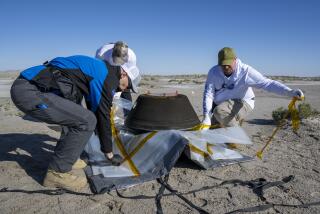Evidence Shows Asteroid Hit Earth 3.5 Billion Years Ago
- Share via
WASHINGTON — Nearly 3.5 billion years ago, when the Earth was just a billion years old, a huge asteroid slammed into the young planet and produced a global rain of glass droplets and towering tidal waves that raced around the world, according to an analysis of ancient rocks.
Researchers at Stanford University and Louisiana State University say samples collected from deposits in South Africa and Australia show that a space rock about 12 miles wide smashed into the Earth and sent into the atmosphere millions of tons of dust and vaporized rock.
The rock samples have been age-dated at 3.47 billion years old and are the oldest known evidence of an asteroid impact on the Earth, said Donald R. Lowe, a researcher at Stanford University and a senior author of the study appearing today in the journal Science.
Lowe said that although evidence of the impact was found in Australia and South Africa, the movement of the Earth crust in the billions of years since has wiped out any crater created by the asteroid. It did leave a concentrated layer of iridium, a chemical common in space rocks but rare on Earth.
“This is the oldest record of an asteroid impact ever found on Earth,” said Gary R. Byerly, a professor of geology at LSU and co-author of the study.
He said the primitive Earth was heavily bombarded earlier in its history, but evidence of those events has been erased by geologic changes.
Steven Stanley, a Johns Hopkins University expert on the early history of Earth, said it is known from other studies that the early solar system was filled with rock and dust left over from the formation of planets. During the first few hundred million years, he said, this debris often slammed into the Earth and the other planets.
“We know there was a lot of material that hit the Earth back then,” Stanley said. “What is interesting about this work is that they were able to find evidence from an impact that far back.”
Lowe said the asteroid that hit Earth 3.47 billion years ago was about twice the size of the 6-mile-wide space rock that struck 65 million years ago and killed off the dinosaurs. When the earlier crash occurred, bacteria were the only forms of life on the planet, he said.
And it is a good thing: Lowe said anything larger than microbes would almost certainly have been wiped out.
Lowe said that as the huge asteroid sped toward the Earth, it would have punched a hole through the atmosphere, leaving in its wake a brief vacuum.
“When the meteor hits the surface, it instantaneously melts and vaporizes rock and that rock vapor is sucked right back up the hole into the atmosphere,” he said.
Since the continents were only beginning to form at the time, most of the Earth was covered with water.
“It would have taken only a second or two for a meteor that’s 20 kilometers [12 miles] in diameter to pass through the ocean and impact the rock beneath,” Lowe said. The impact would have created immense tidal waves--rising perhaps a mile or more in height--that raced around the globe again and again, scouring the ocean floor and eroding any bits of dry land, he said.






